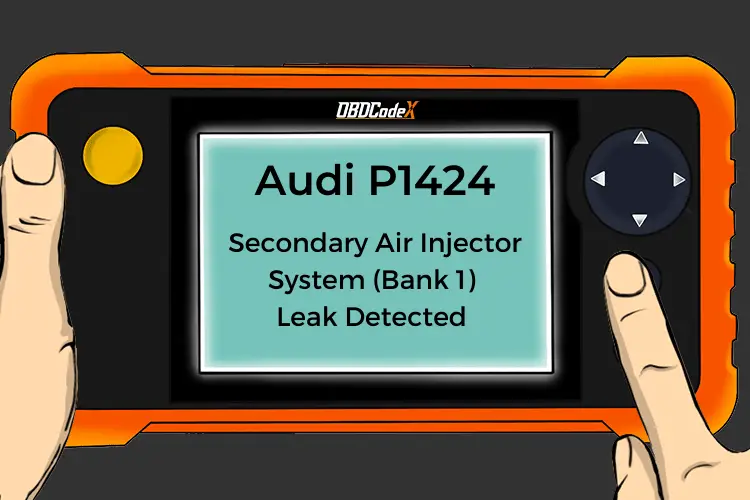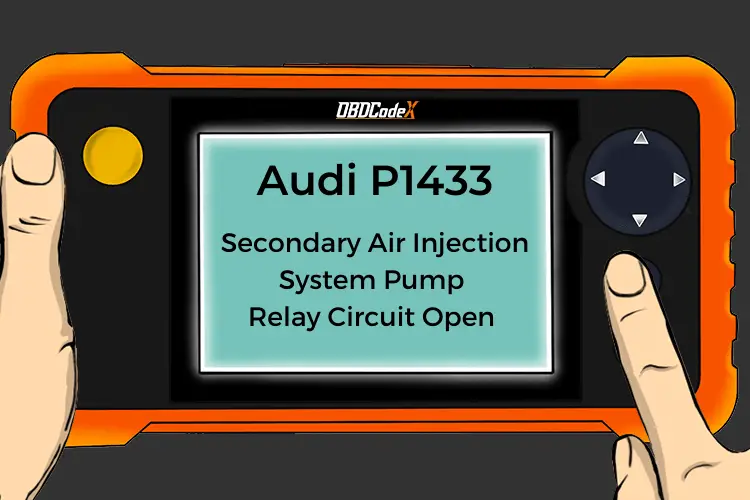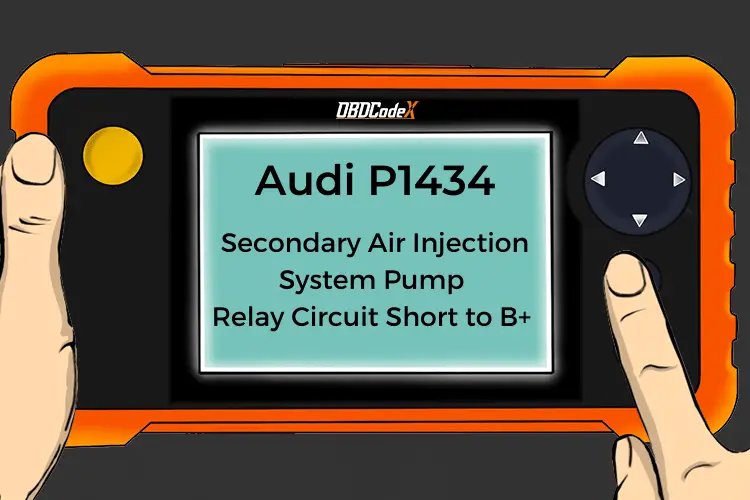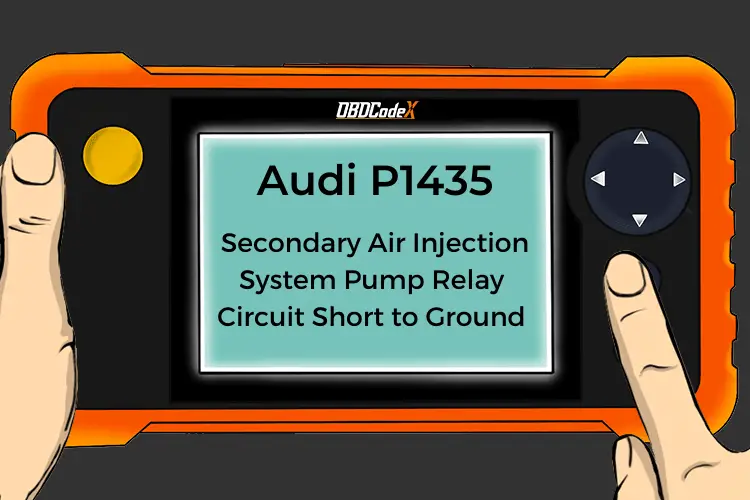P0492: Secondary Air Injection System Insufficient Flow (Bank 2)
Is your scanner showing P0492?
No worries. We'll show you what it means and how to deal with it.
P0492: Secondary Air Injection System Insufficient Flow (Bank 2)
OVERVIEWWhat Does The P0492 Code Mean?
The secondary air injection system, commonly found on Audi, BMW, Porsche and VW vehicles – and may be found on other vehicles – features an air pump, an exhaust manifold, an input check valve, vacuum control switch, an electrical input circuit for the vacuum control switch and tons of vacuum hoses.
This system pumps fresh air into exhaust system during cold starts to feed oxygen and exhaust gases. This ensures a more complete burn of harmful emissions – hydrocarbons. After about minute, the system turns itself off.
If the air pump and check valve are faulty, they are normally easier to replace; however, many of the vacuum lines are under or behind the intake manifold. This makes them difficult to reach in most cases. The P0492 code tell there is a fault with the system – usually that the secondary air flow is too low on bank 2. Bank #2 is the side of the engine that does not contain cylinder #1. For bank #1, see code P0491.
Other secondary air injection system trouble codes include P0410, P0411, P0412, P0413, P0414, P0415, P0416, P0417, P0418, P0419, P041F, P044F, and P0491.
What Are The Symptoms Of The P0492 Code?
Symptoms of a P0492 engine code may include.
- Malfunction Indicator Lamp (MIL) illumination
What Are The Potential Causes Of The P0492 Code?
Potential causes for a P0492 may include:
- Faulty exhaust manifold check valve
- A fuse or relay for the secondary air injection pump may be faulty
- A faulty air pump
- Leaking vacuum hose
- A bad vacuum control switch
- A dislodged a vacuum line
- A leak in the hoses/piping between the secondary air injection pump and the Combi or secondary air injection
- A sensor for the secondary air pressure may be faulty
- The combi valve itself is faulty
- The secondary air injection port in the cylinder head may be plugged with carbon
- The secondary air injection ports in the cylinder head may by clogged
How Serious Is This P0492 Code?
We are not affiliated with the producer of this video, but we are including it here as an additional resource for diagnosing your air injection problem(s).
How Can You Fix The P0492 Code?
Most of the diagnostic tests must be done when the engine is completely cold. Some of the follow-up tests may have to wait until the engine completely cools down again – usually a few hours. Some of the tests may also generate additional fault codes. Just remember to clear all of the fault codes when you have found and repaired the problem.
1. Check the pump. Be sure the engine is completely cold. Remove the pressure hose from the pump or from the manifold check valve – whichever is easier to reach. Have someone start the engine while you check to see that the pump is running and pumping air out of the end of the hose or outlet nipple (depending on where you disconnected it). If air is pumping, then go to step 4; if not, go to step 2.
2. Unplug the electrical harness connector from the pump. Apply 12 volts to the pump with jumper wires. The terminal with the brown wire is ground and the other terminal is positive. If the pump runs go to step 3; if not, the pump must be replaced.
3. Make sure the engine is cold, connect the multimeter, then have someone start the engine to do this step. Test the pump harness connector to ensure that it has 12 volts by checking power between the two terminals in the pump harness plug. If you have 12 volts, repeat the first three steps to ensure you did not make a mistake. If you don’t have 12 volts, check the fuses and the relay. If you do find a bad fuse or rely, replace it, then repeat this step to ensure you have power at the harness.
4. Make sure the engine is completely cold. Remove the pressure hose from the check valve. Check to see if air is coming out of the hose when you start the engine. Do not turn off the engine. After a minute does the valve close and stop the air flow? If so, then the check valve is working properly. If the valve did not ope, go to step 5. If the valve stays open remove the vacuum control hose and start the engine – the engine does not have to be cold for this test. If the valve stays open, the valve is bad; if it closed, the vacuum control switch is most likely the problem.
5. For this step, you’ll need a vacuum pump available at auto parts stores. Start the engine with the vacuum pump attached and holding a vacuum check valve nipple. If the valve is open, release vacuum. If the valve closes, the valve is okay. If the valve does not open at all or if it doesn’t close, then the valve needs to be replaced.
6. Let the engine completely cool. Attach the vacuum to the control hose at the check valve. Start the engine. You should have at least 10 to 15 inches of vacuum. If not, you may have to take the vehicle to a shop as further diagnostic testing requires the removal of some engine components. If no vacuum is present or the vacuum readings are low, go to step 7.
7. Locate your vehicle’s vacuum control switch. Trace the vacuum line from the check valve to the switch. Make not of any hardened spots in the hose, cracks or loose connections. Replace the hose if you find any of this, then repeat the test in step 6. If you still have no vacuum, you may have to remove engine parts to get to the switch.
8. Remove the input vacuum line on the control switch. Attach the vacuum gauge to the input hose to test manifold vacuum – with the engine running. If you have no vacuum, replace the vacuum line and repeat this step.
9. Apply vacuum to the vacuum control switch’s input nipple. The valve should be closed and the pump should not hold a vacuum. Apply 12 volts to the control switch’s two terminals with jumper wires. If the switch does not open and release the vacuum from the pump, then the switch needs to be replaced.
Recommended Parts
Below are some recommended auto parts to help you address the trouble code affecting your vehicle and get it running smoothly again:
>>> Exhaust Manifold Check Valve
>>> CrocSee 250 Pieces - Car Fuses Assortment Kit
>>> Nilight 50003R Automotive Set 5-Pin 30/40A 12V SPDT
>>> OEM Secondary Air Injection Pressure Sensor
>>> Ucreative 5FT High Temperature Silicone Vacuum Tubing Hose Black (1/8" (3mm))
>>> Combi Valve
>>> KAIWEETS Digital Multimeter
Note: During the purchasing process, please check carefully whether the part you want to buy fits your car!
Check This Video For Reference
Reference Sources
P0492 Secondary Air Injection System Insufficient Flow Bank 2, OBD-Codes.




